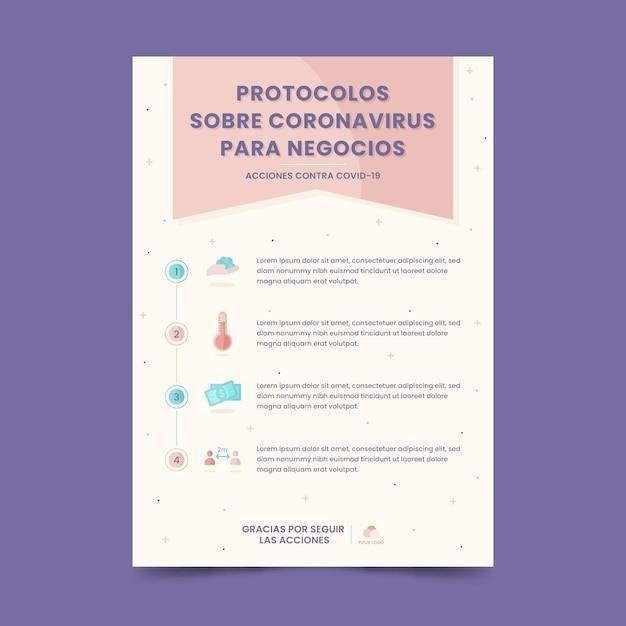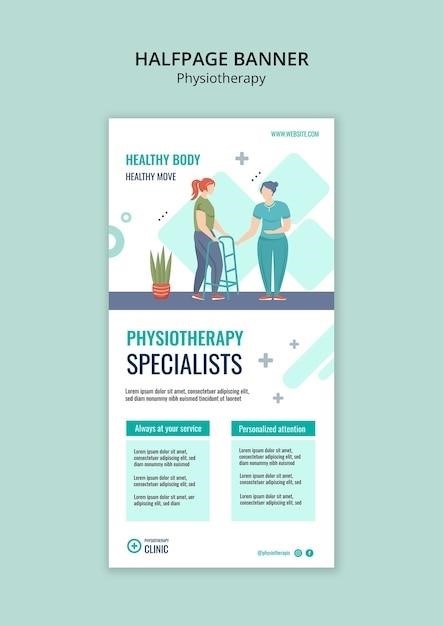Therapeutic Intervention Cheat Sheet⁚ A Comprehensive Guide
A therapeutic intervention cheat sheet is a valuable tool for therapists, offering a concise and organized resource to guide their practice․ It acts as a handy reference for selecting appropriate interventions, streamlining session planning, and enhancing documentation efficiency․ By providing a structured framework, it facilitates better client engagement and progress tracking, ultimately contributing to more effective therapeutic outcomes․
Introduction
In the fast-paced world of therapy, efficiency and effectiveness are paramount․ Therapists are constantly seeking ways to optimize their practice, ensuring they provide the best possible care to their clients․ This is where a therapeutic intervention cheat sheet comes in handy․ This comprehensive guide serves as a valuable resource for therapists, offering a structured framework to navigate the complexities of therapy and deliver tailored interventions․ It is an essential tool for streamlining session planning, enhancing documentation, and ultimately facilitating client progress․
Benefits of Using a Therapeutic Intervention Cheat Sheet
A therapeutic intervention cheat sheet offers numerous benefits, making it an invaluable tool for therapists․ It promotes efficiency by providing a structured approach to intervention selection and session planning, saving valuable time during sessions․ The cheat sheet also enhances documentation by providing pre-formulated sentence templates and key intervention details, simplifying the note-taking process․ Furthermore, it fosters consistency in therapeutic practice, ensuring all clients receive evidence-based interventions tailored to their specific needs․ By organizing and presenting relevant information in a clear and concise manner, the cheat sheet empowers therapists to focus on providing the best possible care, ultimately facilitating client progress and achieving positive therapeutic outcomes․
Key Components of a Therapeutic Intervention Cheat Sheet
A comprehensive therapeutic intervention cheat sheet typically encompasses several key components that are essential for its effectiveness․ It should include a comprehensive list of intervention techniques categorized by therapeutic modality, such as Cognitive Behavioral Therapy (CBT) or Dialectical Behavior Therapy (DBT)․ Additionally, it should incorporate client-specific considerations, such as age, presenting issues, and cultural background, enabling therapists to tailor interventions effectively․ The cheat sheet should also provide guidance on documentation and note-taking, including pre-formulated sentence templates and key elements to include in progress notes․ By integrating these critical components, the cheat sheet becomes a valuable resource for therapists, facilitating efficient and effective intervention selection, session planning, and documentation․
Intervention Techniques
The intervention techniques section of a therapeutic cheat sheet serves as a comprehensive catalog of evidence-based practices therapists can employ to address various client needs․ This section might include techniques like cognitive restructuring, behavioral activation, relaxation training, mindfulness exercises, exposure therapy, and role-playing․ Each technique should be concisely described, highlighting its core principles, applications, and potential benefits․ The cheat sheet may also incorporate specific examples of how each technique can be implemented in practice․ This section empowers therapists by providing a readily accessible toolkit of interventions, enabling them to select the most appropriate techniques based on the client’s unique needs and presenting issues․
Client-Specific Considerations
The client-specific considerations section of a therapeutic intervention cheat sheet acknowledges the unique needs and circumstances of each individual․ This section might address factors like age, cultural background, presenting issues, and individual strengths and weaknesses․ It might also include prompts for therapists to consider, such as⁚ “Is the client comfortable with direct confrontation?” or “What are the client’s preferred learning styles?” By highlighting these critical considerations, the cheat sheet encourages therapists to tailor their interventions to each client’s specific needs, ensuring a personalized and effective therapeutic approach․ This section emphasizes the importance of individualized care and promotes a client-centered approach to therapy․
Documentation and Note-Taking
The documentation and note-taking section of a therapeutic intervention cheat sheet emphasizes the importance of clear and concise record-keeping․ This section might provide templates or pre-formulated sentences for therapists to use when documenting session details, client progress, and intervention strategies․ It might also include prompts for therapists to consider when writing notes, such as⁚ “What were the client’s goals for today’s session?” or “What specific interventions were used and what were the client’s responses?” By streamlining the documentation process, the cheat sheet helps therapists maintain accurate and comprehensive records, which are essential for effective treatment planning and monitoring client progress over time․
Types of Therapeutic Interventions
A comprehensive therapeutic intervention cheat sheet will encompass a variety of therapeutic approaches, providing therapists with a broad range of options․ It might include sections on evidence-based interventions like Cognitive Behavioral Therapy (CBT), Dialectical Behavior Therapy (DBT), and Eye Movement Desensitization and Reprocessing (EMDR)․ Each section could outline key principles, techniques, and common applications of the respective therapy․ The cheat sheet might also touch upon less widely used interventions, depending on the therapist’s specialization and client population․ By presenting a diverse range of therapeutic interventions, the cheat sheet empowers therapists to select the most appropriate approach for each individual client․
Cognitive Behavioral Therapy (CBT)
The CBT section of a therapeutic intervention cheat sheet would typically outline core CBT principles, including the emphasis on identifying and modifying negative thought patterns and maladaptive behaviors․ It might include a list of common CBT techniques, such as cognitive restructuring, behavioral activation, and exposure therapy․ The cheat sheet could also provide brief descriptions of how these techniques are applied in various clinical contexts, such as anxiety disorders, depression, and substance abuse․ Additionally, it might highlight key considerations for incorporating CBT interventions into therapy sessions, such as tailoring techniques to individual client needs and fostering client engagement in the therapeutic process․
Dialectical Behavior Therapy (DBT)
The DBT section of a therapeutic intervention cheat sheet would provide a concise overview of this evidence-based therapy․ It would likely outline key DBT concepts, such as distress tolerance, emotion regulation, mindfulness, and interpersonal effectiveness․ The cheat sheet might include a list of common DBT skills, such as radical acceptance, self-soothing, and assertive communication, along with brief descriptions of how these skills are utilized in therapy․ The cheat sheet might also address specific DBT techniques, such as the use of diary cards for emotion regulation and the development of behavioral chain analyses․ It could emphasize the importance of a collaborative and supportive therapeutic relationship in DBT, highlighting the therapist’s role in providing validation, guidance, and encouragement․
Eye Movement Desensitization and Reprocessing (EMDR)
The EMDR section of a therapeutic intervention cheat sheet would provide a brief overview of this trauma-focused therapy․ It might include a definition of EMDR, highlighting its use in addressing distressing memories and emotional processing․ The cheat sheet could outline the eight phases of EMDR therapy, summarizing each phase’s purpose and key elements․ It might briefly describe the use of bilateral stimulation (e․g․, eye movements, tapping) during the reprocessing phase, emphasizing its role in facilitating emotional regulation and cognitive restructuring․ The cheat sheet could also mention the importance of thorough preparation and desensitization before engaging in reprocessing, as well as the need for ongoing assessment and evaluation throughout the therapy process․
Practical Applications of a Therapeutic Intervention Cheat Sheet
A therapeutic intervention cheat sheet offers several practical applications for therapists․ Its concise format allows for quick reference during sessions, enhancing the efficiency of treatment planning․ Therapists can readily identify appropriate interventions based on the client’s presenting issues, ensuring a focused and tailored approach․ The cheat sheet serves as a valuable tool for documenting progress notes, facilitating clear and concise summaries of interventions implemented and client responses․ This streamlined documentation process saves time and ensures accurate record-keeping․ Moreover, the cheat sheet promotes consistency in therapy delivery, helping therapists maintain a structured and effective approach across sessions, ultimately contributing to improved client outcomes․
Streamlining Session Planning
A therapeutic intervention cheat sheet significantly streamlines session planning by providing a quick reference guide for therapists․ The cheat sheet allows therapists to efficiently select appropriate interventions based on the client’s presenting issues and goals․ By categorizing interventions and providing concise descriptions, it helps therapists focus their session planning on relevant and evidence-based approaches․ The cheat sheet also encourages therapists to consider a range of intervention strategies, promoting a more comprehensive and effective treatment plan․ This structured approach ensures that sessions are well-organized, maximizing time spent on client engagement and progress․
Enhancing Documentation Efficiency
A therapeutic intervention cheat sheet significantly enhances documentation efficiency by providing pre-formulated sentence templates and key terms related to various interventions․ This allows therapists to document their sessions more quickly and accurately, eliminating the need to constantly search for the right wording․ The cheat sheet also helps maintain consistency in documentation, ensuring that progress notes are clear, concise, and easily understandable․ By providing a structured framework for recording session content, the cheat sheet reduces the time spent on documentation, freeing up therapists to dedicate more time to their clients․
Facilitating Client Progress

A therapeutic intervention cheat sheet can directly contribute to client progress by promoting consistent and effective intervention delivery․ By providing a structured framework for selecting and implementing interventions, the cheat sheet helps therapists stay organized and focused during sessions․ This ensures that the most appropriate interventions are chosen based on the client’s specific needs and goals․ Additionally, the cheat sheet can facilitate better communication between the therapist and client․ By clearly outlining the interventions being used and their rationale, clients can gain a better understanding of their treatment plan, leading to increased engagement and motivation․ This enhanced understanding and communication can ultimately lead to more positive outcomes for clients․
In conclusion, a therapeutic intervention cheat sheet empowers therapists to provide more effective and efficient care; By organizing interventions, streamlining documentation, and facilitating client progress, it streamlines the therapeutic process, enhancing both client and therapist satisfaction․ This valuable tool serves as a reminder of evidence-based practices, promoting a more consistent and goal-oriented approach to therapy․ Therapists can leverage this resource to enhance their practice, ultimately improving client outcomes and fostering a more fulfilling therapeutic journey․ It’s important to note that a cheat sheet is merely a tool; it should be used in conjunction with the therapist’s professional judgment and knowledge to ensure the best possible care for each individual client․
